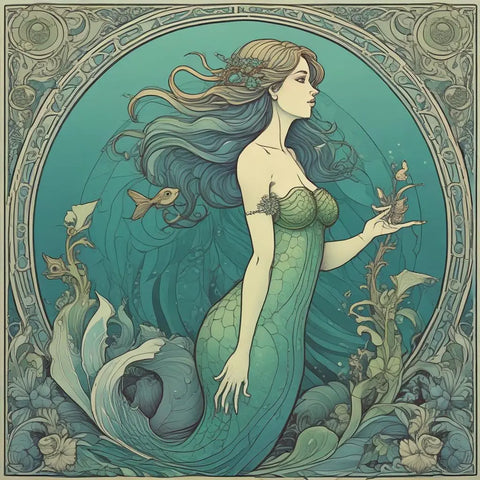The canvas awaits, pristine and brimming with potential, akin to the calm surface of a still lake just before the morning's first brushstroke of a canoe. In a similar fashion, digital artistry calls out, rife with untapped possibilities waiting to be unveiled.
Art in pixels.
As the artist’s hand skillfully wields the stylus, each movement transforms the silence into a harmonious symphony, revealing the unique voice of the creator. Digital art opens up a new horizon for expression and creativity that invites exploration.
Defining Digital Art's Scope
Digital art represents an expansive and diverse domain that transcends traditional artistic mediums, incorporating works created using computers, tablets, and other digital interfaces. It is an intriguing fusion of technical expertise and artistic vision, leading to various forms such as 3D modeling, digital painting, and interactive installations. This variety grants artists countless avenues to share their unique narratives while showcasing their aesthetic innovation.
As an emergent art form, digital creation harnesses the vast capabilities of technology, allowing artists to manipulate virtual canvases in ways that challenge established conventions of classic artistry. The intricate details in vector graphics and the fluid grace of digital brush strokes testify to the transformative power embedded within digital tools, empowering visionary creators to redefine artistic boundaries.
Evolution from Pixels to Complex Canvases
At the foundation of digital art lies the pixel, the elemental unit of digital canvases, which artists skillfully manipulate to construct intricate and captivating visual experiences.
At its core, every digital masterpiece begins with a pixel—a minimalist component that holds a universe of color.
Technological advancements have propelled digital artistry from basic pixelated sketches to hyper-realistic digital paintings, immersive virtual reality experiences, and interactive canvases that dynamically respond to viewer engagement.
These sophisticated platforms facilitate multifaceted creations, merging art with technology, science, and even artificial intelligence, thereby pushing the realm of artistic possibilities to unprecedented heights.
Digital Art Forms and Expressions
Digital art encompasses a myriad of distinct forms, all interconnected through innovative technological applications. At its essence, digital artistry has the ability to bend reality, crafting visions that may not be rendered through traditional media.
The spectrum of these digital expressions spans 2D and 3D digital paintings, animated pieces, and complex installations. Artists leverage advanced software to either replicate physical media or invent entirely new visuals, thus blurring the distinctions between reality and the virtual domain. This diversity invites audiences into interactive experiences, wherein they contribute to the evolving narrative, inviting contemplation and fostering engagement.
Furthermore, the digital landscape serves as a nurturing ground for multimedia art, where sound, motion, and visuals converge to craft immersive experiences. Through these multidisciplinary projects, artists challenge conventional definitions of artistic expression, producing site-specific works that evoke sensory and emotional responses unique to each observer.
As we embrace this digital renaissance, we are witnessing an explosion of generative and algorithmic art: systems where complex codes generate aesthetics, often in real-time. These technologies yield seemingly infinite variations, creating pieces that balance uniqueness with reproducibility. Together with machine learning, generative art glimpses a future where human creativity and computational precision redefine the frontiers of artistic exploration.
Tools of the Trade
The essence of digital artistry lies in its diverse array of tools and technologies. At the heart of this medium are graphic tablets and styluses, serving as the linchpin for artists by translating the fluid strokes of a pen into digital masterpieces. Moreover, sophisticated software suites provide a vast array of features that unleash an unparalleled creative freedom, enabling artists to transcend conventional artistic barriers.
As the craft of digital art progresses, so too does the complexity of its instruments. Professionals frequently employ advanced peripherals such as 3D printers and virtual reality devices to transform their visions into tangible realities. High-resolution displays and cutting-edge software—featuring pressure sensitivity and tilt recognition—enhance the capability to produce works of extraordinary precision and flexibility. In this dynamic domain, the synergy between artist and tool is essential, fostering an unencumbered flow of innovation and artistic expression.
Software Revolutionizing Creation
Innovation in digital art is relentless.
Powerful software has permanently transformed artistic workflows. What once was a domain dominated by physical tools and media has expanded into cybernetic frontiers filled with endless possibilities, thanks to advanced digital art programs. By streamlining processes, elevating precision, and broadening artistic horizons, these platforms serve as the vanguard of the creative sphere.
Software is now the artist's most versatile tool.
Artists weave complex visual narratives through their digital mediums—thanks in no small part to sophisticated programs that provide boundless canvases and tools adept at emulating traditional mediums with striking accuracy. In addition to replicating traditional techniques, these software applications unveil indigenous digital capabilities, creating resources unavailable in physical art forms.
Nuanced techniques flourish under software's continuous evolution. With each update, new features unlock additional realms of creativity, encouraging artists to explore mediums they may never have encountered otherwise. Staying current with software advances is critical for leveraging the full potential of digital artistry.
Hardware Advancing Artistic Precision
The evolution of artistic tools runs parallel to the ascendance of digital art. As practitioners in this field strive for enhanced precision and control, the importance of cutting-edge hardware becomes ever more prominent.
Drawing tablets and styluses, once basic, now feature advanced specifications catering to the most discerning digital artists. Pressure sensitivity, tilt recognition, and virtually lag-free tracking translate subtle movements into exquisitely detailed digital strokes.
Displays have also experienced transformative development, offering artists canvases capable of accurately representing colors and textures. High-resolution screens combined with expansive


